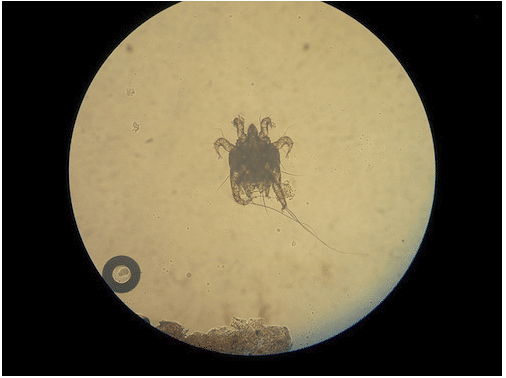How Do Indoor Cats Get Ear Mites?

Contents
“Doctor, how do indoor cats get ear mites, anyway?” Midnight’s owner asked.
The handsome cat was calmly purring on my exam table. His ears were uncomfortable, red and scabby but he was being a good sport.
His owner brought him to the clinic because he couldn’t get rid of the ear mites plaguing Midnight. I noticed the cat’s head and ears were slick from some oily substance. He tried a couple of over the counter medications, but the scabs and scratching persisted.
What Are Cat Ear Mites?
When cat owners notice ear problems, they often jump to the conclusion that their cat has ear mites. How do indoor cats get ear mites and what are they?
Ear mites are eight-legged parasites related to ticks and spiders They’re about the size of a grain of salt. Their scientific name is Otodectes cynotis.
These little buggers feed on the skin and debris produced in an animal’s ear. As they feed, they cause the ear tissue to become irritated and inflamed. Some cats have more of an inflammatory reaction to ear mites than others.
Photo credit CC BY-SA 2.0: fourrure
Otodectes cynotis mite as seen with a microscope
Cats with ear mites have red ears with flakey, black debris in the canal. When your vet looks in the ear with an otoscope, she’ll see tiny white specks crawling on the black debris. A sample of the ear debris examined on a microscope will reveal live mites like the one pictured here.
Ear mites spread by direct contact between animals. They are highly contagious and can affect cats, dogs, and ferrets.
Ear mites can survive off of their host for indefinite periods of time in warm, humid conditions. However, most home conditions are too dry for ear mites to live in the environment. Environmental decontamination is not necessary in most cases.
The answer to the question “how do indoor cats get ear mites?” is that they get them from other infected animals. If your cat develops itchy ears and hasn’t had contact with other animals, ear mites might not be the cause of the problem.
Are Ear Mites Really the Culprit?
Many cat owners overlook the other common cause of ear inflammation in cats: allergies. Cats can be allergic to pollen, dust, dust mites, food ingredients and any number of substances in a home.
Symptoms of allergies can look identical to symptoms of ear mite infections. Luckily, it’s easy for your vet to tell the difference with a simple examination.
Allergic ears with secondary bacterial or yeast infections need specific treatments. That’s why Midnight wasn’t getting better. Anti-ear mite medicine doesn’t help allergic ear symptoms!
Use the Appropriate Treatment for Different Ear Problems
Best Ear Mite Treatment for Cats
Ear mites are easy to get rid of when you use the right medicine. You must treat ALL animals in the home even if they don’t have symptoms. You could use an over the counter pyrethrin-containing product but those take many days to be effective.
I recommend one-time application products so all animals in the home are treated effectively the first time. Products I recommend for treating ear mites include:
- Milbemite- a small vial of liquid that is applied into the ear canals. One treatment is all that’s needed.
- Acarexx- a one-time application of liquid into the ear canal.
- Revolution, Advantage Multi, Frontline or Stronghold Plus- all of these are liquids applied to the skin at the base of the neck (or into the ear for Frontline) and clear mite infections after one or two applications.
Best Treatment for Other Ear Problems
If your cat has ear inflammation but no ear mites, he will need a different treatment. Your vet can perform some simple tests to find out if your cat has a bacterial or yeast infection in his ears.
The most common ear treatments prescribed for cats with ear inflammation not caused by mites include:
- Tresaderm- a liquid containing anti-yeast, antibacterial, and anti-inflammatory agents.
- Conofite- a liquid with only anti-yeast medication.
- Ear cleaner- many different brands available with ingredients to break up wax and normalize the ear environment.
Your vet may prescribe oral or injectable antibiotics and/or steroids if your cat has a severe infection. A hypoallergenic diet is often recommended for a couple of months to help identify food allergies.
So, How Do Indoor Cats Get Ear Mites?
The answer is: indoor cats don’t get ear mites unless they’ve been exposed to another animal with ear mites. Just because your cat has itchy, inflamed ears it doesn’t necessarily mean he has ear mites! Allergy is a very common cause of the same symptoms in cats, even indoor cats.
The moral of the story: don’t waste time and money treating based on your assumption that your cat has ear mites. Take him to the vet to find out why he has itchy ears!
Photo credit CC BY-SA 2.0: fourrure








Your statement about indoor cats not getting ear mites unless they have been exposed to another animal with ear mites is not true. My cats are completely indoor. My veterinarian diagnosed ear mites. He did not believe us when we told him they do not go out. We tried to explain to him the situation, but he didn’t seem to understand. This is the situation: We live in a separate mother-in-law style flat behind the owner’s house. There are dogs in the yard, but there are also, what were once semi-feral cats, but now seem to be 1/4 feral, if that’s possible. Over the years, these cats have become used to us. They still do not let us touch them, but they hang out by our door. They even sleep by our door. I believe the mites are coming under our door from these semi-ferals, even when the door is closed (there is definitely a gap there, because when the owner sprays water on our wall in the hot summer, it gets under the door.) Also, when we open the door, the semi-ferals sometimes stick their foot under the door. This is a situation that I just do not know how to remedy. The outdoor cats like us because we feed them, and so they hang out by our door. I have tried putting diatomaceous earth out there on the pavement by our wall, and putting it at the threshold but it doesn’t seem to be helping.